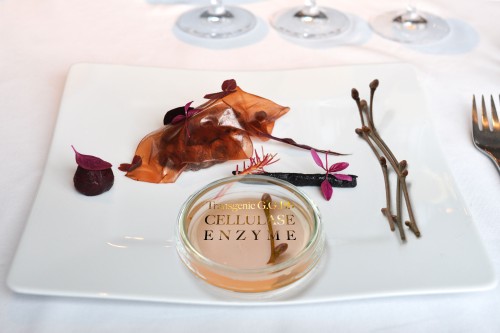Gints Gabrāns in collaboration with Jānis Liepiņš

FOOOD
The project Foood is an artistic interpretation of evolution. It is a reminder of a distant similarity with the genetic mutation that took place in Northern Europe around 7000 years ago that resulted in humans developing an enzyme that could break down lactose. This allowed adult humans to use milk products and gave great evolutionary advantages.
The project Foood is based on the artist’s (Gints Gabrans) genetic modification of metabolic bifidobacteria outside the body giving them the ability to synthesise an enzyme that can break down cellulose. This is done by introducing three additional enzyme encoding genes from the genome of the tree fungus Trichodermareesei.
Cellulose forms the cell walls of all plants. For the human metabolism, the indigestible cellulose cell wall reduces the nutritional energy value of food. Cellulose is glucose polymer of ordinary sugar. These cellulolytic enzymes would allow humans to make a third more efficient use of food from the plant world – potatoes, carrots, cabbage etc. that contain a significant amount of material that is indigestible by humans (cellulose, hemicelluloses and son). They would also allow the more efficient use of completely new types of food resources even, for example, cellulose containing wood and paper.
This idea should be seen in a wider context that is associated with modelling the future, the question of man as an evolving organism, the reduction or complete disappearance of dry land areas suitable for farming, the inaccessibility of fresh water, the unprecedented large expansion of the human population and the ever-increasing lack of food resources and hunger. In the 20th century the human population grew from 2 to 7 billion. According to the forecasts of United Nations specialists, by 2050 the world population will have exceeded 9 billion. This has spawned initiatives to discover new solutions to guarantee food resources in the future.
News
15.07.2014
RIXC comes out with two new publications
14.07.2014A special offer for participants of the World Choir Games 2014!
01.07.2014Through art labyrinths by help of guides
17.05.2014Tickets for the upcoming “Art+Communication'2014” festival audiovisual performances and electronic music concert are now available!
17.05.2014Exhibition and Art+Communication Festival programme
22.04.2014Concert and performance programme confirmed
22.04.2014The Talk to Me book is coming out soon
22.04.2014New Acoustic Space volume No 12: Techno-Ecologies will be out on May 15, 2014
22.04.2014We launch new conference series – RENEWABLE FUTURES
05.04.2014Read the first press release about FIELDS Exhibition
Support

Partners

Information support

